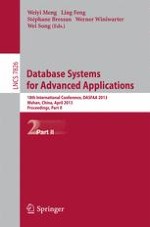This two volume set LNCS 7825 and LNCS 7826 constitutes the refereed proceedings of the 18th International Conference on Database Systems for Advanced Applications, DASFAA 2013, held in Wuhan, China, in April 2013. The 51 revised full papers and 10 short papers presented together with 2 invited keynote talks, 1 invited paper, 3 industrial papers, 9 demo presentations, 4 tutorials and 1 panel paper were carefully reviewed and selected from a total of 227 submissions. The topics covered in part 1 are social networks; query processing; nearest neighbor search; index; query analysis; XML data management; privacy protection; and uncertain data management; and in part 2: graph data management; physical design; knowledge management; temporal data management; social networks; query processing; data mining; applications; and database applications.
